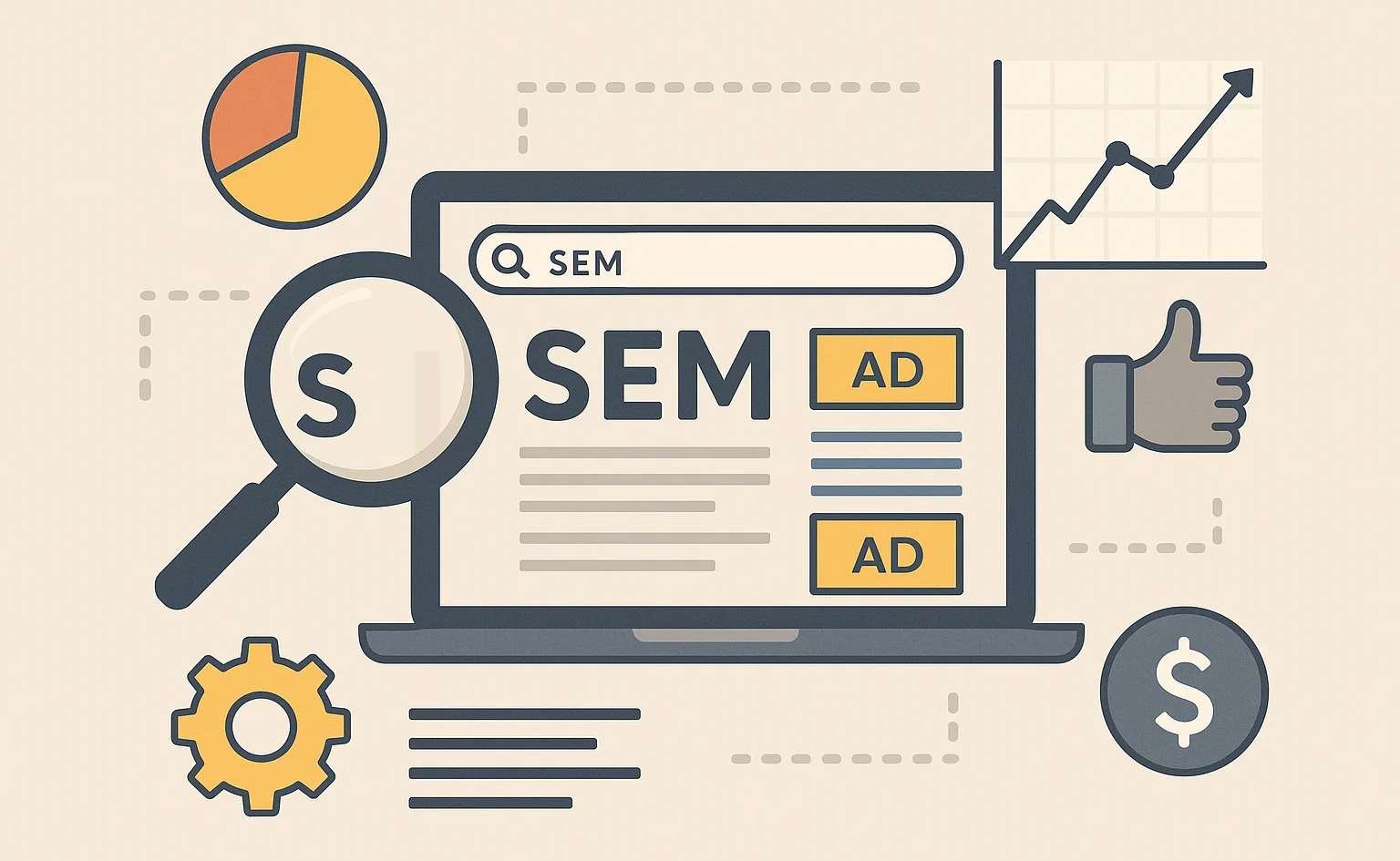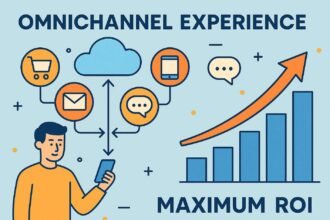Exploring Search Engine Marketing (SEM)
Search Engine Marketing (SEM) is a form of Internet marketing that involves paying for placement in Search Engine Results Pages (SERPs). Historically, SEM primarily meant paid placement listed above and beside the organic listings; however, today’s Paid Search can also appear within and alongside the organic listings. SEM is very much alive and well, growing in importance because it enables advertisers to target users at the very moment they are searching for products or services. When executed properly, Paid Search advertising can be extremely profitable. Yet, the power of Paid Search advertising is often underestimated. Some advertisers are doing it better than ever before, but many still don’t.
Placing your company, products and services in front of customers at the very moment they are searching for it — that’s Paid Search advertising. The challenge is understanding how it works, corporate goals, and how to put together a plan for success. From there, it’s simply a matter of finding the right partners to help you implement the campaign and continue to manage it — including keyword research, identify target goals, creating ads, bid management, testing, tracking results and landing page optimization — and then refining the campaigns over time.
What is SEM?
Search Engine Marketing (SEM), also known as paid search or pay-per-click search engine advertising, constitutes a form of Internet marketing targeting search engines and webmasters. Advertisers bid on keywords that users of services such as Google and Bing might enter when seeking certain products or services, with the search engine displaying ads alongside the search results. SEM is frequently located above and to the right of the organic search results in a layout resembling an auction.
SEM involves efforts to purchase Internet visibility in search engine results, and includes Search Engine Optimization (SEO). While SEO attempts to generate unpaid, organic traffic by enhancing a website’s relevance for specific keywords, SEM consists of purchasing relevant traffic. Paid search advertisements may account for a substantial proportion of a consumer’s overall exposure to search engine marketing; the actual proportion depends on the keyword, the products and services advertised, and the nature of the consumer.
History of SEM
The growth of the internet and user demand led to the introduction of many new services and products, including search engines. With the growing number of websites on the internet, search engines were developed to make it easier for people to find information. Websites are scanned by search engine programs called spiders. Spiders help index the information on all websites. It takes time to build a loyal customer base for any new product and other new. SEM works to promote and advertise websites that have recently opened on the internet.
The impact of SEM on any website is very much faster. It allows new sites to show better search engine positioning on the basis of active bidding through a sponsored placement. In sponsored placement, a website is searched for a specific keyword; the placement ranking of websites with respect to the keyword is decided by the rates given for the ads. Websites with the highest rates appear first in the sponsored placement results. By this way, SEM services reach many people who are more frequently using search engines for any search.
How SEM Works
SEM campaigns are highly targeted, appearing only when users express the desire to locate something specific. Unlike traditional TV commercials, ads within dynamic SEM networks offer such alignment with user wishes that even a product or brand mention can trigger a keyword-triggered campaign exposure. Moreover, ad personalisation allows each impression to be tailored to the individual.
Four core SEM ingredients work in conjunction to deliver an SEM campaign at a fine-grained, impression-by-impression level: Keyword Research, Ad Creation, Bid Management, and Landing Page Optimisation. Keyword Research focuses on devising a list of relevant and commercially viable keywords to represent the search market; Ad Creation involves designing appropriately targeted, text-based advertisements; Bid Managementencompasses crafting the bidding strategy that decides which auction opportunities to exploit; and Landing Page Optimisation identifies the most appropriate webpages to deliver in response to clicked advertisements.
Key Components of SEM
SEM requires completing and optimizing four key components: Keyword Research, Ad Creation, Bid Management, and Landing Page Optimization. While other digital marketing disciplines tend to focus primarily on areas such as content, search engine optimization, or social media, SEM is different in that it identifies a much broader spectrum of critical factors that must work together in order to be successful.
Keyword Research — Understanding the words consumers are likely to use when searching online is the foundation of best-in-class SEM. Straightforward keyword research, however, represents only a small component of the overall process. The majority of SEM work is dedicated to directing the highest possible levels of traffic to the campaign ad, a process that requires significant thought and expertise. Advanced SEM practitioners will go beyond basic keyword research by targeting specific consumer profiles or including some of the more obscure keywords to ensure that no valuable millimetres of opportunity go unused.
Ad Creation — The mechanism behind SEM rests in creating an online advertisement that entices consumers to click on a link, which, in turn, moves them again down the marketing funnel.
Bid Management — The past decade has seen extraordinary growth in SEM and a resulting increase in associated competition. The bidding system is designed in such a way that the advertiser willing to spend the most amount of money per click will generally have his or her advertisement shown on the results page fruit.
Landing Page Optimization — The journey from making a click to closing a sale is one that includes a variety of possible stumbling blocks.
Keyword Research
Exploring Search Engine Marketing (SEM) Search Engine Marketing (SEM) is a branch of online marketing that involves the promotion of websites in search engine results pages (SERPs) mainly through paid advertising. It is one of the fastest-growing industries in the world, primarily because it allows advertisers to place their products in front of a potential customer as they search the internet. What Is SEM? SEM is the acronym for Search Engine Marketing SEM accompanies Search Engine Optimization (SEO) in the search marketing realm. While SEO aims at obtaining free, natural or organic placement within the search engine results, SEM is the practice of marketing a business using paid advertisements that appear on the search engine results pages (or SERPs). These advertisements appear at the top or bottom of the organic results.
How SEM Works SEM campaigns are created to achieve different objectives: brand awareness, lead generation, direct sales, etc. However, they are all built around a core process consisting of four components: Keyword Research, Ad Creation, Bid Management and Landing Page Optimization. Together they represent the anatomy of SEM Keyword Research, the backbone of a Search Engine Marketing campaign. Keyword research is used to determine which words or phrases should be purchased based on search demand and the traffic those keywords are predicted to send. It can also be useful in focused SEM campaigns, when the goal is to target an industry, interest or behavior. Although the goal is usually to focus on specific keyword themes during the research, it is necessary to spend time researching keywords unrelated to the main product because they might deliver incremental traffic.
Ad Creation
Ad Creation involves the development of content that will be displayed to users. Such ads are ideally paired with associated keywords selected during the Keyword Research process. Each ad performs best when grouped into an Ad Group, a set of ads all targeting a similar keyword target. Advertisers can structure these groups to focus on particular demographics or locations, thus achieving greater precision in market targeting.
Search engine advertising requires bid management to ensure favorable rankings against competitors. Advertisers can employ automated online interfaces provided by search engines to optimize media buys, thus maximizing return on investment for dollar spent on clicks. Careful attention to bidding strategies is necessary to minimize the expense for traffic obtained while maintaining a presence at the top of the results page for targeted user searches.”
Bid Management
SEM requires advertisers to compete for keywords and phrases relevant to their products or services. Through keyword research, advertisers determine which terms to bid on. Bid management consists of controlling how much an advertiser bids for specific keywords or placements. Controls can be automated or manual. The advertiser sets a maximum bid and the advertising platform adjusts the bid based on competition and other factors. A bid increase uses more of the campaign’s budget to try to advertise more frequently or in a higher placement. A bid decrease can prevent an advertiser from exhausting the budget too quickly. Other bid management strategies aim to optimize for a high return on investment.
SEM campaigns are built by selecting the advertising platform (Google Ads or Bing Ads), type of campaign (Search Network, Display Network, Shopping, etc.), campaign goals, location of searchers, language of searchers, budget, a set of keywords, and ad copy. Once uploaded, the advertising platform starts displaying the ads according to the chosen settings. How often and where an ad is displayed is determined algorithmically.
Landing Page Optimization
Although landing page optimization could be considered a part of SEO, it has an important role in SEM when it comes to generating Quality Scores for paid ads and increasing conversions. It is an underrated part of an SEM campaign.
The landing page should be optimized for the campaign, i.e., it should be created specifically for the ad group to give the user the best experience in terms of relevance and persuade them to complete the action on the page. Key factors include headline, page copy, and image, which should be relevant and persuasive, aligned with the keyword intent and the ad copy.
Differences Between SEM and SEO
Successful online marketing demands a deep understanding of the relationships between Search Engine Marketing (SEM) and Search Engine Optimization (SEO). Both SEM and SEO are common ways to increase a website’s visibility in search engines; however, these two approaches differ in many fundamental ways. An overview of the main differences between SEO and SEM offers crucial insights into how both can complement each other in a comprehensive online marketing strategy.
Search Engine Optimization is the art of improving your position in search engine result pages (SERPs) by using Keyword Research on your website’s content pages, building backlinks, and creating content that appeals to Google. In contrast, Search Engine Marketing encompasses paid advertising within the SERPs. Paid advertisements provide a shortcut to the first page when launching a website, a brand-new product, or service. However, it is important to bear in mind that paying for advertising is more expensive than pursuing organic optimization and requires clear targeting and a defined budget for the campaign.
Definition Comparison
Search engine marketing is a digital marketing discipline that leverages paid advertising to promote websites within the search engine results pages. By offering advertisers the opportunity to present visually appealing and relevant ads to users searching for related products and services, this form of online marketing has witnessed substantial growth over the past decade. Google Ads, the largest search engine advertising platform, generates the majority of the search engine marketing traffic. Search engine marketing (SEM) is a form of Internet marketing that involves the promotion of websites by increasing their visibility in search engine results pages (SERPs) primarily through paid advertising.
SEM encompasses the various methods employed to make a website more visible in search engine results pages, including paid advertising. When targeted keywords match the search queries of users, search engines display these ads prominently within the search results, typically at the top or right side of the pages, and form part of pay-per-click advertising. The price paid to search engines is usually based on either the cost per click (CPC) or cost per impression (CPM) models. Advertisers select keywords relevant to their specific services and can also determine the target location of the advertisements. SEM is often confused with search engine optimization (SEO), which focuses on improving search rankings through non-paid methods like content optimization. However, unlike organic SEO, SEM traffic can be obtained virtually immediately after launching an ad campaign.
Cost Structure
SEM operates on a pay-per-click (PPC) cost structure, meaning that advertisers are only charged when users actually click on their ads. While PPC pricing is most widely used, advertisers can also pay for impressions or achieve powerful results with retargeting. The PPC bidding process involves advertisers selecting a series of search terms for which their ads might appear. Whenever a user enters a query containing those terms, the search engine generates a real-time auction for a favorable ad placement on the search results page.
The winning ads are labelled as “Sponsored” to distinguish them from organic listings. This allows native ads to enjoyed the credibility of appearing on an established search engine, while also maximizing conversion potential because the ad matches an active search query. The bidding process is dynamic and allows for adjustments based on factors such as budget, cost per action, average bid position, and time of day. Implementing user targeting, geo-inclusive or geo-exclusive targeting, and devices targeting also enhances the flexibility and effectiveness of SEM campaigns.
Time to Results
SEM is part of a broader discipline referred to as search engine marketing, which focuses on generating traffic and visibility from both organic search listings and paid advertising listings. SEM incorporates activities related to SEO, as well as those associated with setting up and optimizing pay-per-click (PPC) campaigns in search ad engines like Google Ads and Bing Ads.
Search engine marketing represents an ever-changing landscape. The internet’s dynamic and technologically-advancing nature continually provides new tools and opportunities to get in front of targeted users. These developments help SEM professionals remain creative and reach broader audiences. Both small local businesses and major international companies recognize the importance of having a well-designed search engine marketing plan.
Long-term vs Short-term Strategies
Search Engine Marketing (SEM) helps a company establish brand recognition and keeps it in front of potential customers. In contrast to Search Engine Optimization (SEO), which offers a long-term benefit, SEM provides advertisers immediate visibility. While SEO involves making adjustments to a website to rank higher in organic results, SEM involves paying search engines to display the company’s ad. In other words, SEO improves the quality of the website and its relationship with users and search engines over time, whereas SEM is an instant marketing strategy where the advertiser pays search engines to display ads for relevant keywords.
With SEM, shoppers already searching for the products or services a company provides are exposed to its content. Clearly, this is a powerful way to gain greater market share and grow sales, as it offers unique opportunities for targeted advertising and detailed measurement and tracking. When conducted properly, SEM can have a significant impact on an organization’s revenue.
Advantages of SEM

Search engine marketing has a broad range of advantages, including the following:
Fast Results: Sem advertising campaigns can be activated much faster than search engine optimization campaigns, and impact on search engine results pages is often visible within hours. The process of speed depends on advertising budget and other factors.
Easy to Start: Setting up a sem campaign is quite straightforward. A Google adword account, for example, typically takes only a few minutes to create and setup. The ability to quickly launch a campaign allows advertisers to capitalize on current events, promotions, and company news with greater ease than search engine optimization tactics.
Highly Targeted: Sem campaigns can be very specific and granular in their targeting. Advertisers can select geographically where the ads will be presented, ex. state, city, radius around a specific zip code, or fluids market area.
Flexible Price Point: Advertisers are able to run ads at virtually any price point. Daily, monthly, quarterly, and yearly budgets can be established, and most search engines offer the ability to run ads on a limited budget.
Target Specific People: Sem allows for the opportunity to reach people based on specific demographics, location, device, time, past visits to the website, or even compelling products or services visitors have viewed.
Deep Measurability: Reporting (+- 15 minute delay) is near real-time and available on multiple levels/campaigns/ad groups. By enabling conversion tracking, advertisers are able to attribute sem campaign actions taken on the website or in an app or on a mobile device.
Brand Building: A search engine marketing campaign enhances and supports organic results. Native ads, and placement atop the SERPs, make it highly visible.
Immediate Visibility
Search Engine Marketing (SEM) is a form of digital marketing that involves creating and placing online advertisements on search engines to target audiences at the right moment. Although the term SEM has been used to describe different methods of online marketing, it is most commonly associated with paid search or pay-per-click advertising.
An effective SEM campaign can increase website traffic and raise brand awareness. In contrast to Search Engine Optimization (SEO), which requires a long-term strategy to increase ranking, SEM allows immediate ranking on the top pages of the Search Engine Result Pages. Many business owners find SEM necessary to gain rapid growth of website traffic and visibility. It serves as a source of revenue, thereby increasing profits.
Targeted Advertising
Search engine marketing (SEM) is a form of Internet marketing that involves the promotion of websites by increasing their visibility in search engine results pages (SERPs) primarily through paid advertising. It encompasses all paid search activities, including clickable ads placed atop natural search results that direct visitors to the advertiser’s website. Historically, SEM initially denoted search engine optimization only.
SEM campaigns endeavor to optimize ad copy and graphics, choose appropriate keywords, and track campaign success through click-through and conversion rates. Searches in which a user enters a query into the search box of a search engine can be termed a paid search. The results and advertisements that appear on the SERP are collectively referred to as paid or sponsored links; sponsors place bids on keywords and pay the search engine only when users click on the links (through cost per click (CPC) or pay per click).
Measurable Results
SEM enables measurement and quantification of specific results, such as sales generated by an advertisement. Advertisers can also opt to avoid paying for SEM campaigns unless customers act by clicking the advertisement and visiting the advertiser’s website. Other measurable results include target market actions such as buying a product. These capabilities provide actionable intelligence on advertising effectiveness and return on investment.
SEM campaigns can be analyzed and compared using different main business-related metrics: cost per action (CPA), cost per click (CPC), and cost per mille (CPM). CPA measures the aggregate cost required to acquire a consumer who completes an action that the advertiser desires, such as making a purchase. CPC measures the advertiser’s cost for each click on an advertisement delivered through an online marketing campaign. CPM determines the cost an advertiser pays for every thousand impressions received on online advertisements.
Flexible Budgeting
The budgeting flexibility of SEM can be considered one of its most alluring advantages, as it makes SEM campaigns feasible for a great many advertisers with widely differing financial resources. At one end of the scale, corporate behemoths can drop considerable sums directly into an advertising account and begin purchasing almost immediately, gaining instantaneous exposure and the prospect of similarly rapid returns. At the other end of the scale, a smaller business can commit a relatively modest sum and carefully manage its SEM campaign to evaluate potential returns before deciding whether to add to its monthly budget. Regardless of the campaign budget, however, well-crafted SEM campaign components, including tightly controlled ad groups and budget thresholds, can help businesses target the most valuable prospects at the optimal times and in the most advantageous locations and thereby maximise the return on their advertising investment.
The transition from offline to online advertising brings many challenges, some of which are already familiar to digital marketers. The online space is much more crowded than ever before, even in the search engine sponsored advertising arena, so marketers have to be ready to fight harder to reach their prospects with their own brand messages. Ads of every shape and size are beginning to fill the available advertising real estate, whether on the search engine results pages or the myriad websites that make up the so-called Display Network. This clutter and competition can lead purchasers to become progressively less responsive to the messages they receive, a phenomenon known as ad fatigue. Although it is difficult to avoid ad fatigue, one effective way to combat it is to test different ad copy and fresh new offers on a regular basis, using analytical tools to find the most appropriate content for the moment.
Challenges of SEM
Despite the many important advantages of Search Engine Marketing (SEM), it does have some noteworthy challenges. The biggest ones are the competition and/or rising cost per click (CPC) over time and the potential for ‘banner blindness,’ where consumers tend to ignore ads within the search engine results. Even if the advertisements are placed top of the page or in a higher position, very few users (remember the CTR table) actually click on the ads. Google has also added a cost per conversion calculation to many of its keyword offerings. Hence, there are times when a high volume of above keywords, the $0.01 is delivered 95% of the time and even on occasions when the $0.01 keyword is delivering 102% of the volume, the cost per conversion cannot be sustained and the account must pause or shut down.
This often times seems to be confusing to marketers; setting the keyword cost per click at $0.01, but it eventually has the ability to spend, for example, $100 a day or $3,000 a month. The reason for this is that the cost per click is an average and with that average cost per click, it might be necessary to spend more to capture more qualified traffic/conversions. If the movement is from $0.01 to $0.50 or $1.00 per click, the brand and company must be prepared for the cost increase and possible ROI decrease as well.
Competition
SEM is a discipline that enables companies to be in the right place, at the right time when consumers are actively searching for their products and services on Google and Bing. Being highly targeted and measurable, SEM enables marketers to see return on investment and optimize budget spend between marketing channels. Competitors are bidding for these coveted ad spots, along with the chance to gain better brand awareness.
As Google and Bing Ads move away from the default 4-3-2-1 ad formats, marketers must continuously evaluate what works best to maintain strong click-through rates — and expose their ads to as many users as possible. Both platforms offer multiple extensions to help increase the real estate of an ad. The combinations can be very useful in increasing click-through rates but can also drive ad fatigue when the consumer is in view of the same ad repeatedly.
Ad Fatigue
SEM is the discipline of marketing a business using paid advertisements that appear on search engine results pages. Advertisers bid for ad placement in a search engine’s sponsored links when a user searches on a keyword that is related to their business offering. For example, if a locksmith in Dallas wants to use SEM, they might bid on the keyword “locksmith in Dallas.” When a user searches for that keyword, the search engine places the ad at the top of the search results, and the locksmith receives a higher visibility for that search.
Ad fatigue occurs when an audience sees an ad so many times that it starts to lose its effectiveness—people stop clicking on it or begin to actively ignore it. The same ad running over and over eventually hits a ceiling in conversions. Tips for preventing ad fatigue include: testing new channels, isolating ads based on device, rotating your creatives regularly, and continuously optimizing your ad copy.
Complexity of Management
After preparing SMART goals and a SEM tool, the campaign for effective marketing on Google will be prepared, followed by several checks. After launching, the campaign regularly requires maintenance and control to ensure its effectiveness and avoid budget waste. As a tool, Google Ads helps manage these tasks by allowing changes, including pausing, activating, or editing campaigns, with multiple options requiring experience and thorough knowledge of Google Ads. Maintaining Google Ads campaigns is important because constant analysis uncovers weaknesses and threats from competitors; regular handling leads to optimization, minimizes risk and wasted budget, and ultimately controls marketing performance times.
To manage the complexity of Google Ads, it is advisable to seek assistance from a specialist, especially for beginners. Agencies dedicated to Google Ads provide related consulting services and analysis of client campaigns. Although specialist help may increase costs, the savings achieved is often multiple times greater. Google Ads campaign maintenance entails constant updates, adjustments, and optimizations aligned with Google Ads algorithm changes and market trends. An expert adjusts configurations and strategies, including budget allocation, to maintain campaigns active and aligned with defined SMART goals.
How to Set Up an SEM Campaign
Search Engine Marketing (SEM) launches a new product or service onto search engines by gaining paid search listings, allowing higher rates of traffic to be directed to its website and appearing higher on search engine listings. The campaign uses targeted advertisements and paid keywords to drive traffic through sponsored advertising listings on search engines. This process differs from Search Engine Optimization (SEO), which focuses solely on maximizing natural (unpaid) search listings. Setting up an SEM campaign presents challenges that vary with the market, but the following steps describe how to build a basic SEM campaign.
Choosing the SEM platform is the first step; Google Ads, Microsoft Advertising, and Yahoo! Ads are well-known for their ability to drive targeted paid traffic at scale. In setting up the campaign, the marketing team first considers the goals of the advertising campaign: whether the key objective is brand awareness, video views, engaged views, or website visits. Budget settings come next. Setting a budget for a campaign means the advertiser decides how much money they want to spend on a single day or for the total duration of the campaign. Lastly, targeting is defined. Targeting allows the company to understand who their customer is and where they can be found on the Internet through tools like demographics and interests groups.
Choosing the Right Platform
Several advertising platforms exist, including Google Ads, Bing Ads, Amazon Ads, Facebook Ads, and Twitter Ads. An SEM advertiser must evaluate the target audience demographic, geographic location, age, sex, platform reputation, platform popularity, and several other factors before opening an account on any one platform. For SMS objectives such as audience encouragement of product or service usage, creating awareness, remarketing or searching for competitors, additional keywords suggestive of SMS objectives can be recommended.
Using the SMS analysis, keywords can be edited or added to the existing list of keywords during the performance evaluation period. When the budget is no longer sufficient for creating awareness, campaign keywords can be reduced or modified to match other objectives such as remarketing. Similarly, an advertiser may reduce the number of keywords for a particular campaign, or bid lower, or pause the campaign, or remove all keywords targeting competitors, when the objective turns out to be remarketing rather than searching for competitors. An SMS tool can deliver such suggestions to the advertiser.
Setting Goals and Objectives
Establishing clear objectives in mainstream initiatives arguably enhances goal attainment. Setting goals precedes execution; it is an initial management step. The first step is a query: Why undertake marketing? In mainstream marketing, the answer seems obvious—any product or service must be actively promoted to achieve continuous sales, revenue, and related business outcomes. Yet an answer is nevertheless required. Although marketing can be reactive (responding to inquiries and delivering services without active promotion), the objective is to generate more business from every existing and potential source. Execution differs if the answer is simply “business development.”
Setting campaign goals might begin with selecting venues and methods, including banner advertisements, search engine marketing, Yahoo! Paid Inclusion, and e-mail marketing. Perhaps an e-mail campaign clarifies objectives—offering a reasonable topic and discount to a chosen target group more likely to appreciate and act accordingly. Advertising preserves currency and increases awareness of services, business, and partners. Yet, engaging and appealing content is underemphasized, and such campaigns demand continuous updates. Failure to maintain an ongoing campaign can lead to imprudent advertisements.
Budgeting and Bidding Strategies
In paid search ads, the ranking of ads on the search engine results page (SERP) is mostly determined by the advertiser’s maximum bid, i.e., the maximum amount that the advertiser is willing to pay for a user click on their ad. However, this mechanism favors advertisers with the deepest pockets. To level the playing field and encourage ad quality, search engines use an ad rank formula. The ad rank is calculated as the product of the Maximum Bid and the Quality Score (Ad Rank=Maximum Bid×Quality Score). While advertisers choose the maximum bid, it is the search engine that assigns the Quality Score. The Quality Score is typically calculated based on estimated click-through rates, ad relevance to the user query and website user experience.
Besides the ad executives, there exist several budget analyses that aid in bid management. Recent work argues that the bid plan of companies affects their budget management and that the most influenced sectors are the smaller ones. Indeed, recent research highlights that abandoned web shops mainly come from micro-enterprises and small enterprises.
Ad Targeting Options
The ability of search engines to determine when advertisements display is dependent on the ad targeting options activated within the campaign. The most common ad targeting option is keyword targeting, where all the keywords added are activated for ad targeting. This is the based SDK for SEM–and the ones highlighted to this point. The text-based search advertising that hosted such success for the Hotwire Group used keyword targeting only. Without keyword targeting, Hotwire could not have enabled the user to perform a search query and receive a relevant price display. Without Hotwire, the idea of selling airline tickets through advertising would have been flawed.
Keyword targeting was once the most powerful option within the managers’ toolkit. It is still the most relevant when the customer wants to buy something right now. But now, advertisers have the option of utilizing additional targeting options on all searches–or other targeting options leveraging additional technologies. These so-called situational targeting options either expand keyword targeting beyond the text-based search query–or replace keyword targeting entirely with The new targeting options represent the next step in the search evolution.
Best Practices for SEM
Search engine marketing (SEM) is a form of digital marketing that aims to increase website visibility on search engine results pages (SERPs). Unlike search engine optimization (SEO), which targets unpaid or natural search results, SEM advertises websites using paid search advertising. SEM is primarily associated with the first four listings on a search-engine results page (SERP), although it can be displayed anywhere on the page. Google AdWords, Microsoft’s Bing Ads, and Yahoo! Ads are common forms of SEM.
Campaign management is a critical factor in the success of SEM, rewarded with higher Quality Scores by the engines, which can lower the cost per click. According to Google, Quality Score is Google’s rating of the quality and relevance of your keywords and pay-per-click ads. Best practices involve generating strong, unique landing pages for each search campaign, increasing the Quality Score and relevancy of the page, and subsequently lowering the cost per click associated with the page.
Continuous Keyword Optimization
Understanding Search Engine Marketing (SEM) is essential, as automated tools simplify many technical aspects. Consequently, the principal challenges in setting up and managing an SEM campaign are strategic: determining how keyword, bid, and targeting–settings affect performance; assessing changes in reverse; deciding on responsive actions; defining key performance indicators; allocating budget across campaigns and account categories; and structuring accounts optimally. Continuous Keyword Optimization Even with highly relevant ads and attractive landing pages, the inherent keyword-to-keyword competition of the placement mechanism can—and frequently does—distort search detail pages. Automated Placement Several major providers offer automated placement mechanisms that shield advertisers from key elements of ongoing campaign performance. These services take over campaign operation, continuously modifying the settings to achieve a designated goal, often highest return on advertising spend. Before activating the automated mechanism (often a “maximize conversions” or a “maximize conversion value” option), it is advisable to optimize campaign settings manually. Starting with the search term report—which lists the exact search terms that triggered the ads and their corresponding KPIs—manual optimization is based on the insight that any keyword with a conversion rate below the target converts too rarely, wasting ad–bonus–landing page resources. Time and cost constraints may prevent continuous bidding or setting–optimization at the keyword level. This can be addressed by optimizing individual keywords through combination with ad bids from a bid–optimization tool, such as Google Ads’ “Recommendation” function or third–party tools. Simple Manual Optimization Even a basic, manual keyword optimization can significantly improve campaign performance. The key lies in setting the correct KPIs and ensuring that optimization occurs regularly (at least twice a week). For instance, a standard Google Search campaign aimed at acquiring new customers with a Cost Per Acquisition target of EUR 50 would consider any keyword with a Cost Per Acquisition of EUR 100 (twice the target) a bad performer. On average, across campaigns: • Keywords with a CPA that is twice the target should be paused, • Keywords with a CPA 1.5 times higher should have the bid reduced by 30%, and • Keywords with a CPA 50 percent higher should have the bid reduced by 10%.
A/B Testing Ads
People rely on a search engine every day for information like stocks, news, online games, weather, and health resources. Search engine marketing can establish your brand’s online presence, adapt your messages to your targeted audience, deliver fast, measurable results, and help you stay in line with market demands. Further, product and ad campaigns can be developed for customers at the precise moment they are demonstrating interest in your products and services, in the locations your business serves, and at the exact times when orders can be taken. Search engines provide detailed reports on the effectiveness of your campaigns. This data is invaluable in determining the return on investment for your marketing dollars, as well as in shaping future campaigns. A critical capability of any successful campaign is the ability to build, measure, and analyze different versions of an advertisement’s message. This allows advertisers to discover which message is most effective, better match the audience’s expectations, and improve the overall reach and appeal for their campaigns.
Making use of the multitude of features that a search engine offers is made easier with some guidance. One key technique in designing the best ad possible for the given audience is the analysis and comparison of different ads created through testing. Analytics data helps answer vital business questions such as “Who really clicked on my ads?” or “Do ads with more questions get more clicks?” These answers then aid decision-making, event selection, and key performance indicators for the testing—ensuring advertising efforts remain effective. Smart marketers test differently worded ads against each other whilst keeping nearly identical budgets until performance patterns emerge. Although testing these ads can be done continually, it is recommended to run tests for a minimum of two weeks to capture enough data to make intelligent decisions about market response and cost-effectiveness.
Monitoring and Analytics
The highly measurable nature of SEM campaigns also offers a significant advantage. Pay-per-click campaign managers can view the walk-in rate via the advertisers portal. Other custom reports are available for impressions, clicks, CPC, CTR and quality score. Hvart also provides a feature that allows managers to compare the performance of a paid search keyword list against a website’s Google Analytics traffic historical behavior. By comparing the click’s behavior with the keywords historical behavior in Google Analytics, the search engine marketer can quickly determine the effectiveness of their paid keyword list. junit est cases2 vacntssutii rrueksesyum emg The success or failure of an SEM campaign relies heavily on the choice of keywords used for targeting. Selecting the right keywords allows advertisers to reach potential customers from the pool of those who are actively looking for the products or services they offer. Keyword ranking in organic search results affects SEM as well. For example, if a Google user searches for ‘flowers’ and the first page results are dominated by flower shops in New York, Starbucks promotions, and automobile ad campaigns, the results are irrelevant. A pay per click advertiser may bid to appear in these irrelevant search results. However, the actual consumer may just skip the ad and continue searching for the intended keyword or product.
Future Trends in SEM
Artificial intelligence is impacting search, with Google integrating ChatGPT-like conversational AI in search results. The future of paid search marketing may be AI-driven platform assistance. Voice search gain popularity, with 27% of the global online population using voice search on mobile. Voice search differs from text, being longer, more conversational, and more local. Advertisers can optimize campaigns for voice search by understanding voice queries and adjusting messaging.
Privacy and trust are paramount. Regulations such as GDPR, CCPA, and Google’s announcement to phase out third-party cookies in Chrome affect search marketing. Advertisers must prepare by adhering to policies and respecting user preferences. Search advertising remains the most effective channel for online businesses. A presence on search engines is analogous to physical stores on high St and Broadway. Without visibility, businesses forego clicks, contacts, sales, and profits.
AI and Automation
The advances of AI and automation have proven to be quite valuable to search engine marketing. Creating ads can be a tedious task when ad copy has to be generated for many different keywords. Additionally, targeting a wide variety of potential customers can be difficult with static copy. Provided with multiple headlines and description lines across different ad campaigns, Google’s machine learning can be utilised to automatically optimize the performance of ads in different contexts.As a result of Katherine Moon’s research, it was found that automated bidding contributed a 10% increase in revenue at 20% lower cost when compared to manual bidding.
Search Engine Marketing (SEM) is defined as Internet advertising that involves the promotion of websites by increasing their visibility in search engine results pages (SERPs) primarily through paid advertising. SEM’s roots can be traced back to the very early days of the search engine marketing industry when the first paid ads were introduced alongside the organic search results on the web. To set up an SEM campaign, advertisers have to first choose the keywords they want to target. Keywords can be broadly defined as the words and phrases that potential customers prefer when they want to find some product or service. The next step is to create an ad based on how the potential customer searched for them with these keywords. The created advertisements are then given a link to the advertiser’s website where the potential customers can see specific information about the advertiser’s product or service. Small businesses, as well as large corporations, have found success using the SEM strategy.
Voice Search Impact
Voice Search Impact
This section highlights the influence of voice search technology on search engine marketing. Growing consumer usage has prompted marketers to optimize for natural language queries, especially longer questions reaching the top of the funnel. Recognizing consumer use of voice for local business information also encourages the adoption of local SEO best practices.
What Is Search Engine Marketing (SEM)?
Search engine marketing (SEM) is a form of Internet marketing that involves the promotion of websites by increasing their visibility in search engine results pages (SERPs) primarily through paid advertising. SEM may incorporate search engine optimization (SEO), which adjusts or rewrites website content to achieve a higher ranking in search engine results pages to enhance pay per click (PPC) listings.
History of SEM
The term SEM was popularized by Danny Sullivan in a September 2001 article in Search Engine Watch. Search engine marketing became popular in the mid-2000s as the number of internet users increased. With the growth of online shopping, individuals turned to the web for product searches, permitting marketers to queen to buying decisions through paid advertisements on search engines.
How It Works
SEM involves a diverse range of activities. The process begins with keyword research, site optimization, campaign set-up, ongoing management, and analysis and reporting. Keyword research identifies search terms that consumers likely enter when shopping online. The SEM team then incorporates these into campaigns on various locations including Amazon Advertising, Google Ads, Microsoft Ads, Pinterest Ads, Quora Ads, and other paid advertising platforms.
Key Components
1. Keyword Research: Understanding the consumer’s intent through search terms. 2. Ad Creation: Developing well-written text advertisements that direct consumers to the appropriate landing page with a clear call-to-action. 3. Bid Management: Adjusting bids on keywords for optimal returns. 4. Landing Page Optimization: Designing landing pages that encourage consumers to purchase. All elements must be aligned and tooled to fit with the consumer’s search terms to enhance buying experience. Bid management involves ongoing adjustments to ensure that SEM bids are optimized to receive maximum return on investment.
Differences Between SEM and SEO
SEM refers to paid search activities, while SEO refers to organically optimizing the website and content to rank higher on the SERPs. SEM has an accelerated effect, enabling it to quickly do market testing to determine what clicks, conversions, and can contribute to top-line revenue growth. In contrast, SEO builds a more sustainable and longer-lasting platform to help increase brand awareness. They both have their unique benefits, and their combined contribution provides the brand with a better outcome.
Privacy and Data Regulations
Ensuring privacy and adhering to data regulations form a crucial foundation for trustworthy advertising. The applicable rules aim to afford users transparency and privacy, affecting the mechanisms by which advertisements reach their intended recipients. Searching for queries, locations, or products traditionally triggered contextual advertising. However, by 2006, queries were instead categorized under hundreds of categories, and it was determined which advertisements and content were relevant to this category. A large industry of companies assisted advertisers and publishers with regulatory compliance and supported self-regulation.
The practical effect of self-regulation is that advertisements experienced by users adhere to acceptable content guidelines and rules for safe viewing. Two organizations—CMA TH and TRUSTe—had begun to assist in regulation. High-profile political tracts such as the Killian documents also became subject to national rules and regulations. The CHI honors were one of a very few awards involving industry and government that were deemed relevant to these areas.
Case Studies of Successful SEM Campaigns
In recent years, SEM has played a vital role in advertising campaigns for traditional businesses, e-commerce ventures, and app developers alike. Through proper execution of SEM best practices, Google Ads has been able to attract billions of dollars in revenue every year for Alphabet Inc, the parent company of Google.
Apple Inc. launched its mobile search ad campaign in 2016, aiming to feature highly relevant ads aligned with user search queries. The objective was twofold: to enhance the App Store’s user experience and to present marketing schemes for app publishers. A periodontist clinic in Edmonton, Canada, also turned to Google Ads for SEM solutions. The clinic developed a targeted strategy using Google Ads keywords to attract new patients.
Concluding Insights and Essential Highlights
After defining Search Engine Marketing (SEM) and illustrating its differences from Search Engine Optimization (SEO), the discussion turns to the specific advantages offered by paid advertising via search engines. It then explains how to establish an SEM campaign using an online tool and highlights best practices for SEM. Although challenges have been noted, it remains an essential traffic source for many websites, and the section concludes by exploring future trends and presenting case studies of successful campaigns.
SEM enables businesses to target potential customers precisely when they express intent by searching for related products or services. Unlike other advertising forms that depend on assumptions about customer characteristics or exposure, SEM delivers messages to users actively seeking relevant offerings, substantially increasing the likelihood of click-throughs and sales. SEM campaigns can be launched across various platforms, with Google Ads representing the most prominent and widely utilized option.












